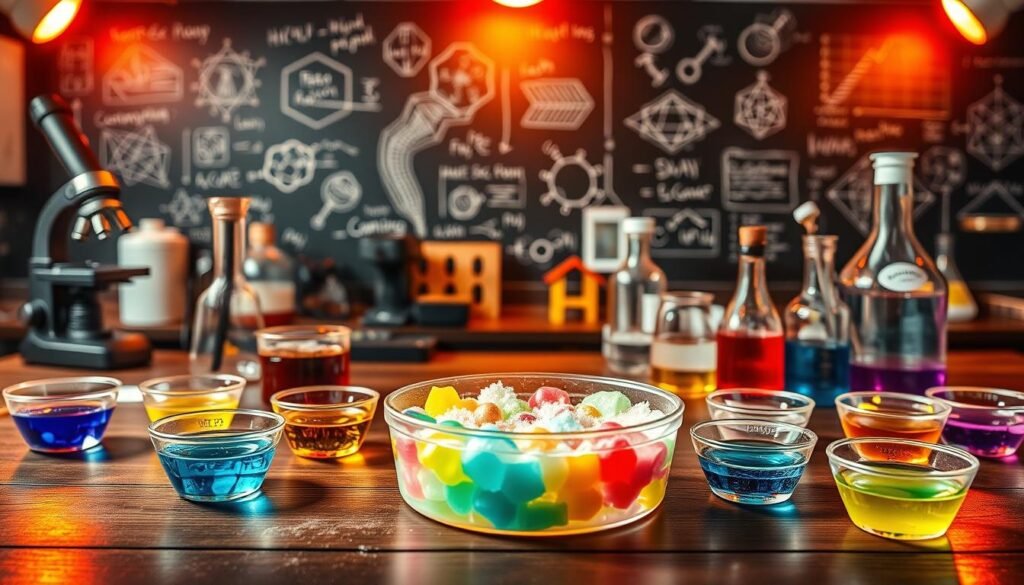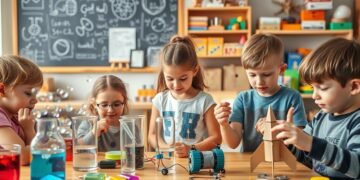Have you ever wondered if everyday items in your home could spark a love for science in your child? The answer is yes! Your kitchen can transform into a hands-on learning space where kids explore fascinating concepts like chemical reactions and states of matter. With simple, non-toxic ingredients and a little creativity, you can create a safe and engaging environment for discovery.
Books like Kitchen Science Lab for Kids provide trusted guidance, making it easy to turn cooking activities into lessons in measurement and chemistry. The best part? No specialized equipment is needed. Just grab what’s already in your pantry and let the fun begin. Always remember, adult supervision ensures safety while kids learn and explore.
Key Takeaways
- Your kitchen is an accessible space for hands-on learning.
- Safety is key—use non-toxic ingredients and adult supervision.
- Simple activities teach concepts like chemical reactions and states of matter.
- Books like Kitchen Science Lab for Kids offer reliable guidance.
- Cooking naturally introduces measurement and chemistry skills.
Introduction to STEM Experiments in the Kitchen
Everyday food items can unlock a world of scientific discovery. Your kitchen is a treasure trove of ingredients that demonstrate basic principles of science. From observing how sugar dissolves in water to watching dough rise, these simple activities make learning tangible and fun.
Start with easy explorations, like examining the structures of fruits or vegetables using a magnifier. This helps kids see the tiny details they might miss otherwise. It’s a great way to introduce them to the wonders of biology and chemistry.
Baking and cooking are perfect for observing transformations. Watch how heat changes the texture of eggs or how yeast makes bread rise. These processes teach kids about chemical reactions and states of matter in a hands-on way.
Begin with free exploration, then gradually introduce structured labs. For example, measure ingredients to learn about fractions or track the time it takes for water to boil. This builds foundational skills in math and science.
Don’t forget the cross-curricular connections. Discussing nutrition while preparing meals ties science to real-life health lessons. Your kitchen isn’t just for cooking—it’s a space for endless learning and creativity.
Fun Chemistry Experiments with Kitchen Staples
Transform your kitchen into a chemistry lab with simple ingredients. These activities make learning about chemistry exciting and accessible. From bubbling volcanoes to colorful reactions, kids will love exploring scientific concepts in a hands-on way.
Baking Soda and Vinegar Volcano
Create a classic reaction by mixing baking soda and vinegar. This combination produces carbon dioxide gas, causing a bubbly eruption. It’s a fun way to demonstrate acid-base interactions.
Magic Milk: Exploring Surface Tension
Pour milk into a shallow dish and add drops of food coloring. Then, dip a cotton swab in dish soap and touch the milk’s surface. Watch as the colors swirl and dance, showing how soap breaks down fat molecules.
Lemon Volcano: Acid-Base Reactions
Cut a lemon in half and add a few drops of food coloring. Sprinkle baking soda on top to create a fizzy reaction. This experiment highlights the acidity of citrus fruits and introduces pH concepts.
These activities are not only fun but also teach fundamental principles of chemistry. They’re perfect for sparking curiosity and making science accessible to everyone.
Kitchen Physics: Density and States of Matter
Discover how everyday materials can teach fundamental physics concepts. From layered liquids to homemade lava lamps, these activities make learning about density and states of matter both fun and educational. All you need are a few household items to get started.
Layered Density Tower
Create a colorful tower by comparing the densities of liquids like honey, syrup, and vegetable oil. Pour each liquid slowly into a clear container, and watch as they separate into distinct layers. This simple activity demonstrates how different substances interact based on their density.
Homemade Lava Lamp
Combine water, oil, and food coloring in a plastic bottle to explore immiscibility. Add an effervescent tablet, and observe the bubbly reaction. This project highlights the principles of liquid separation and chemical reactions in a visually captivating way.
Ice Cream in a Bag: Freezing Point Depression
Mix cream, sugar, and vanilla in a small plastic bag. Place it inside a larger bag filled with ice and salt. Shake vigorously to observe freezing point depression in action. The result? A delicious treat that teaches kids about phase changes and temperature.
Biology and Food Science: Learning with Edible Experiments
Biology and food science come alive with simple, edible activities you can try at home. These hands-on projects make learning about life processes and food chemistry both fun and delicious. From growing sugar crystals to making butter, each activity teaches important scientific concepts in an engaging way.
Growing Crystals with Sugar
Create rock candy to explore supersaturated solutions. Dissolve sugar in hot water until no more can dissolve. Then, pour the solution into a jar and suspend a string or stick inside. Over several days, sugar crystals will form, demonstrating how molecules arrange into solid structures.
Bouncy Egg: Exploring Osmosis
Soak an egg in vinegar for 24-48 hours. The vinegar dissolves the shell, leaving a rubbery membrane. This activity shows how liquids pass through semi-permeable membranes, a key concept in cellular biology.
Butter Making: Emulsification in Action
Fill a jar halfway with heavy cream and shake vigorously. As the cream separates into butter and buttermilk, you’ll see emulsification in action. This process teaches how fats and liquids interact, a fundamental principle in food science.
These activities not only teach science but also connect to real-world applications like food preservation and crystallization patterns. They’re perfect for sparking curiosity and making learning delicious.
Engineering Challenges with Kitchen Items
Turn everyday materials into creative engineering challenges right at home. These hands-on projects teach problem-solving and design principles using simple items you already have. From building structures to harnessing natural energy, these activities make learning fun and practical.
Egg Drop Challenge
Design an impact-resistant container using only pantry materials. This classic project teaches kids about structural integrity and force distribution. Test different designs to see which one protects the egg best when dropped from a height.
Building a Solar Oven
Construct a solar oven using reflective foil and a black heat-absorbing surface. This activity demonstrates how sunlight can be harnessed for cooking. Experiment with angles to maximize heat absorption and learn about renewable energy.
Walking Water: Capillary Action
Explore the science of water movement with colored liquid and paper towels. Place two cups of water with food coloring next to an empty cup. Connect them with paper towels and watch as the water “walks” through capillary action. This simple experiment illustrates how plants absorb water.
These activities not only teach engineering concepts but also encourage creativity and critical thinking. They’re perfect for making learning interactive and enjoyable.
Conclusion: The Value of Kitchen STEM Experiments
Hands-on activities with everyday materials offer a unique way to spark curiosity and foster a love for learning in kids. These simple projects not only teach scientific principles but also develop cross-disciplinary skills like measurement, observation, and critical thinking. Best of all, they’re cost-effective compared to commercial kits, making them accessible to everyone.
Encourage kids to document their discoveries through lab notebooks or photo journals. This helps reinforce scientific reasoning and problem-solving abilities. Plus, it creates a tangible record of their progress and creativity.
For those looking to expand their exploration, resources like Kitchen Science Lab for Kids provide excellent guidance. These activities connect science to real-world applications, from healthy living principles to everyday problem-solving. Turn your home into a hub of discovery and watch kids thrive!
FAQ
What are some safe and fun chemistry experiments I can try at home?
You can create a baking soda and vinegar volcano, explore surface tension with magic milk, or make a lemon volcano to learn about acid-base reactions. These activities use common kitchen items and are perfect for kids.
How can I teach my child about density and states of matter using kitchen supplies?
Try building a layered density tower with liquids like honey, water, and oil. You can also make a homemade lava lamp or experiment with ice cream in a bag to understand freezing point depression.
Are there edible experiments that teach biology and food science?
Yes! Grow sugar crystals to learn about crystallization, create a bouncy egg to explore osmosis, or make butter to understand emulsification. These experiments are both educational and tasty.
What engineering challenges can I do with kitchen items?
Try the egg drop challenge to test impact resistance, build a solar oven to harness energy, or explore capillary action with the walking water experiment. These activities encourage problem-solving and creativity.
Why are kitchen-based experiments valuable for learning?
They make science accessible, using everyday items to teach concepts like chemistry, physics, biology, and engineering. Plus, they’re hands-on, engaging, and fun for all ages.







